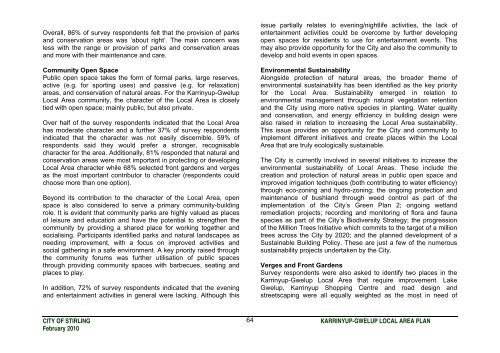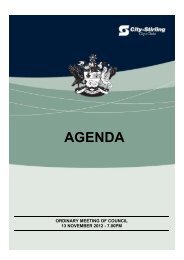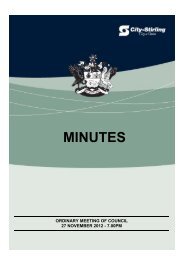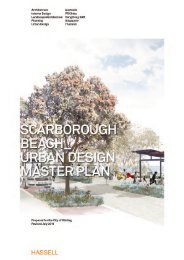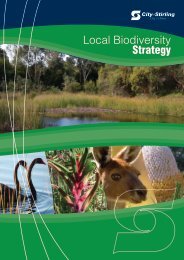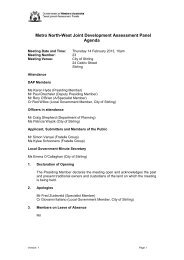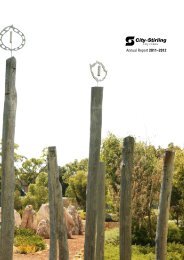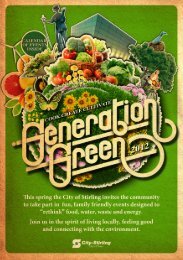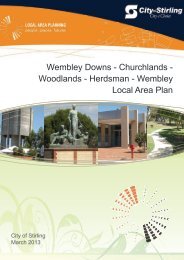KARRINYUP / GWELUP Local Area Plan - City of Stirling
KARRINYUP / GWELUP Local Area Plan - City of Stirling
KARRINYUP / GWELUP Local Area Plan - City of Stirling
Create successful ePaper yourself
Turn your PDF publications into a flip-book with our unique Google optimized e-Paper software.
Overall, 86% <strong>of</strong> survey respondents felt that the provision <strong>of</strong> parks<br />
and conservation areas was ‘about right’. The main concern was<br />
less with the range or provision <strong>of</strong> parks and conservation areas<br />
and more with their maintenance and care.<br />
Community Open Space<br />
Public open space takes the form <strong>of</strong> formal parks, large reserves,<br />
active (e.g. for sporting uses) and passive (e.g. for relaxation)<br />
areas, and conservation <strong>of</strong> natural areas. For the Karrinyup-Gwelup<br />
<strong>Local</strong> <strong>Area</strong> community, the character <strong>of</strong> the <strong>Local</strong> <strong>Area</strong> is closely<br />
tied with open space; mainly public, but also private.<br />
Over half <strong>of</strong> the survey respondents indicated that the <strong>Local</strong> <strong>Area</strong><br />
has moderate character and a further 37% <strong>of</strong> survey respondents<br />
indicated that the character was not easily discernible. 59% <strong>of</strong><br />
respondents said they would prefer a stronger, recognisable<br />
character for the area. Additionally, 81% responded that natural and<br />
conservation areas were most important in protecting or developing<br />
<strong>Local</strong> <strong>Area</strong> character while 68% selected front gardens and verges<br />
as the most important contributor to character (respondents could<br />
choose more than one option).<br />
Beyond its contribution to the character <strong>of</strong> the <strong>Local</strong> <strong>Area</strong>, open<br />
space is also considered to serve a primary community-building<br />
role. It is evident that community parks are highly valued as places<br />
<strong>of</strong> leisure and education and have the potential to strengthen the<br />
community by providing a shared place for working together and<br />
socialising. Participants identified parks and natural landscapes as<br />
needing improvement, with a focus on improved activities and<br />
social gathering in a safe environment. A key priority raised through<br />
the community forums was further utilisation <strong>of</strong> public spaces<br />
through providing community spaces with barbecues, seating and<br />
places to play.<br />
In addition, 72% <strong>of</strong> survey respondents indicated that the evening<br />
and entertainment activities in general were lacking. Although this<br />
issue partially relates to evening/nightlife activities, the lack <strong>of</strong><br />
entertainment activities could be overcome by further developing<br />
open spaces for residents to use for entertainment events. This<br />
may also provide opportunity for the <strong>City</strong> and also the community to<br />
develop and hold events in open spaces.<br />
Environmental Sustainability<br />
Alongside protection <strong>of</strong> natural areas, the broader theme <strong>of</strong><br />
environmental sustainability has been identified as the key priority<br />
for the <strong>Local</strong> <strong>Area</strong>. Sustainability emerged in relation to<br />
environmental management through natural vegetation retention<br />
and the <strong>City</strong> using more native species in planting. Water quality<br />
and conservation, and energy efficiency in building design were<br />
also raised in relation to increasing the <strong>Local</strong> <strong>Area</strong> sustainability.<br />
This issue provides an opportunity for the <strong>City</strong> and community to<br />
implement different initiatives and create places within the <strong>Local</strong><br />
<strong>Area</strong> that are truly ecologically sustainable.<br />
The <strong>City</strong> is currently involved in several initiatives to increase the<br />
environmental sustainability <strong>of</strong> <strong>Local</strong> <strong>Area</strong>s. These include the<br />
creation and protection <strong>of</strong> natural areas in public open space and<br />
improved irrigation techniques (both contributing to water efficiency)<br />
through eco-zoning and hydro-zoning; the ongoing protection and<br />
maintenance <strong>of</strong> bushland through weed control as part <strong>of</strong> the<br />
implementation <strong>of</strong> the <strong>City</strong>’s Green <strong>Plan</strong> 2; ongoing wetland<br />
remediation projects; recording and monitoring <strong>of</strong> flora and fauna<br />
species as part <strong>of</strong> the <strong>City</strong>’s Biodiversity Strategy; the progression<br />
<strong>of</strong> the Million Trees Initiative which commits to the target <strong>of</strong> a million<br />
trees across the <strong>City</strong> by 2020; and the planned development <strong>of</strong> a<br />
Sustainable Building Policy. These are just a few <strong>of</strong> the numerous<br />
sustainability projects undertaken by the <strong>City</strong>.<br />
Verges and Front Gardens<br />
Survey respondents were also asked to identify two places in the<br />
Karrinyup-Gwelup <strong>Local</strong> <strong>Area</strong> that require improvement. Lake<br />
Gwelup, Karrinyup Shopping Centre and road design and<br />
streetscaping were all equally weighted as the most in need <strong>of</strong><br />
CITY OF STIRLING 64<br />
<strong>KARRINYUP</strong>-<strong>GWELUP</strong> LOCAL AREA PLAN<br />
February 2010


